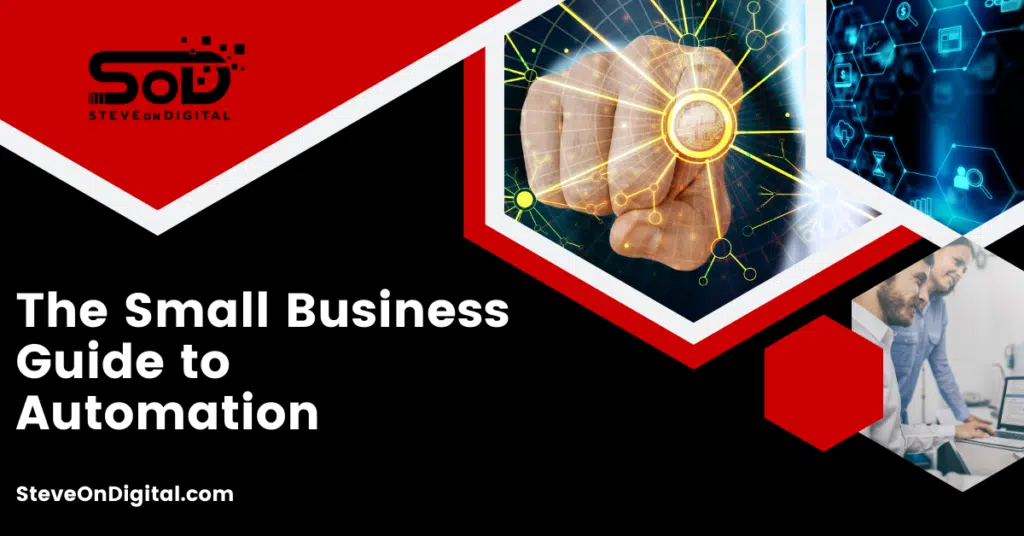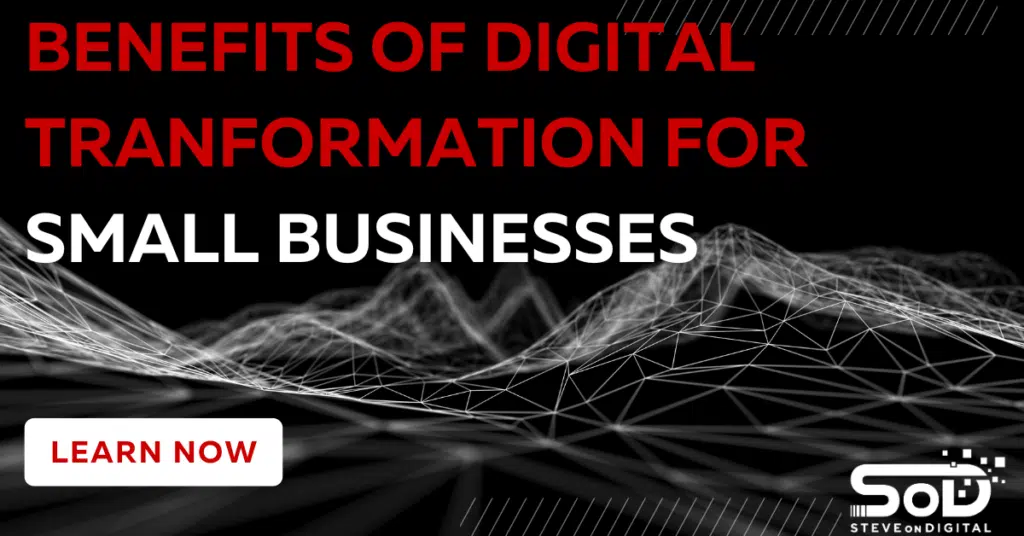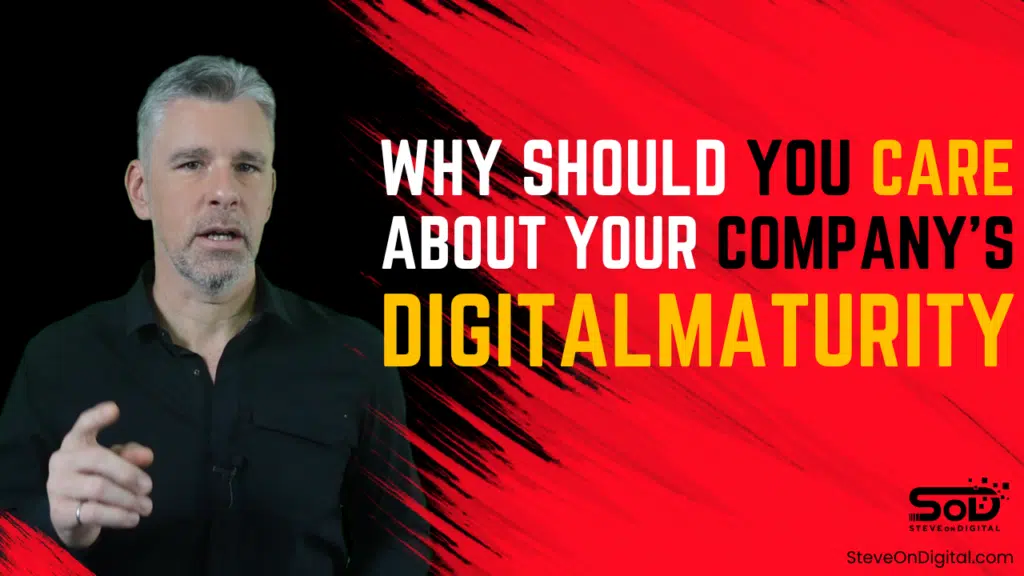Digital Marketing Strategies For Small Business | Ultimate Guide

Digital marketing encompasses all marketing efforts that use an electronic device or the internet. Businesses use the internet, like search engines, social media, email, and other websites, to talk to people who might buy their stuff, and to keep in touch with the ones who already do. For small businesses, it’s not just an option; it’s an essential way to reach your audience, execute marketing strategies effectively, and foster growth. Digital marketing has evolved from traditional methods to a complex ecosystem that enhances how businesses engage with their customer base. For me, Steve Johnston, diving into digital marketing was a transformation from traditional marketing methods to embracing technological advancements that empower small businesses to compete on a global scale. Importance Of Digital Marketing For Small Businesses Digital marketing offers small businesses a platform to compete with bigger competitors and reach a wider audience without needing a hefty budget. Benefits include increased visibility, higher website traffic, and improved conversion rates. From my experience, using digital marketing strategies effectively has led to noticeable improvements in sales and customer engagement without the overhead costs associated with traditional marketing. Crafting A Robust Digital Marketing Strategy Setting Foundations: Goals And Target Audience Identifying your target audience is the first step to creating an effective digital marketing strategy. Knowing what people like, how they act, and what bothers them helps you make your marketing fit exactly what they want. As a small business owner, I’ve found that setting SMART goals—Specific, Measurable, Achievable, Relevant, and Time-bound—provides a clear roadmap and measurable targets for our digital marketing efforts. Developing Your Digital Marketing Plan A successful digital marketing plan integrates various strategies to ensure a comprehensive approach to reaching your target audience. This includes using a mix of social media marketing, content marketing, SEO, and email marketing to create a diverse and robust marketing strategy. Leveraging digital marketing tools has been a game changer in how I plan and execute campaigns, providing valuable insights and analytics to refine strategies continually. By understanding the nuances of digital marketing and how to implement effective strategies, small business owners can maximize their potential to attract new customers, engage existing ones, and drive growth. My approach has always been to focus on creating high-quality content and leveraging digital tools to optimize every aspect of our marketing campaigns, ensuring every strategy is well-suited to the dynamics of today’s digital world. Strategy Benefits Tools Often Used SEO Increases organic reach and visibility Google Analytics, SEMrush Content Marketing Engages and retains customers WordPress, Canva Social Media Marketing Builds brand awareness and customer loyalty Hootsuite, Buffer Email Marketing Personalizes customer communications Mailchimp, Constant Contact Core Strategies In Digital Marketing Search Engine Optimization (SEO) SEO is the practice of optimizing your business website to rank higher in search engine results, thus driving more organic traffic to your site. As a small business owner, mastering the basics of SEO has been pivotal in increasing our website traffic and enhancing our online visibility. Key strategies that have proven effective include optimizing our site with relevant keywords and improving site speed and mobile responsiveness. Through diligent application of these tactics, we have seen a marked improvement in our search engine rankings, making it easier for potential customers to find us online. Content Marketing High-quality content is the backbone of any successful digital marketing strategy. It not only helps attract customers but also retains them by providing helpful information and engaging experiences. Over the years, I have focused on creating content that resonates with our target audience, from informative blog posts to interactive videos. This approach has significantly boosted our ability to engage existing customers and attract new ones by delivering valuable content that meets their needs. Social Media Marketing Social media platforms are an essential tool for building a strong online presence and engaging directly with your audience. I have utilized various social media channels to share content, announce new products, and engage in real-time with our community. Creating compelling social media posts and running targeted social media ads have been crucial in enhancing our brand’s online presence and engaging with the community. These efforts have allowed us to foster a strong social media presence, helping drive website traffic and increase sales. Email Marketing Email marketing is a powerful tool for small business marketing, allowing for direct communication with potential and existing customers. It has been instrumental in nurturing leads and converting them into loyal customers by providing them with targeted information and offers. Best practices I’ve adopted include personalizing emails and segmenting our audience to ensure the right messages reach the right people. Through effective email marketing campaigns, we have been able to maintain a direct line of communication with our customers, driving both engagement and sales. Advanced Digital Marketing Techniques Paid Advertising And Google Ads Paid advertising, particularly pay-per-click (PPC) campaigns, is a crucial component of digital marketing strategies for small business. As a small business owner, I’ve leveraged Google Ads to specifically target prospective customers who are searching for services we offer. This direct approach helps in driving targeted website traffic quickly and effectively. Designing effective ads involves understanding the target customer’s needs and crafting messages that resonate with them. Using relevant keywords and a clear call-to-action has significantly increased our click-through rates and driven more conversions. From my personal experience, continuous testing and adjustment of ad copy and targeting options are vital to optimize the performance and ROI of your PPC campaigns. Video Marketing Video marketing has become an indispensable part of a strong online presence. The ability to convey complex information in an engaging and digestible format makes video a powerful tool to attract customers. As someone who has integrated video content into our digital marketing efforts, I’ve seen firsthand the impact of sharing helpful information and personal stories through video. Tips for creating impactful video content include focusing on storytelling, maintaining high-quality production, and ensuring content is informative and directly beneficial to the viewer. Using videos on social media platforms and our business website
The Small Business Guide To Automation | SteveOnDigital

Hey everyone, Steve Johnston here from SteveOnDigital. Today I will share my thoughts and experiences on how small businesses can use automation. This is based on real data and practices that will work for you. So let’s get started! The Small Business Guide to Automation What And Why? Business automation is using technology to do tasks or jobs in a business that people do by hand. This is key for small businesses because it speeds up by simplifying things and allows you to focus on strategic tasks that grow the business. Adding small business automation to your operations can simplify and automate more tasks, speed up productivity, and allow you to focus even more on innovation and growth. Small Business Operations Automation can speed up small business operations by automating tasks. Efficiency through automation allows small businesses to reduce time spent on admin tasks, reduce data entry errors, and speed up response to leads and customer inquiries. In today’s digital world being competitive means being able to act fast and automation gives you that power. Automation in small business operations is a key to unlocking new levels of efficiency, scalability and growth, and ultimately customer satisfaction. Where To Automate Manual Tasks To Automate In my experience running a digital transformation consultancy I’ve seen a pattern of tasks that small businesses can automate: Benefits Of Automating Boring Tasks The benefits are clear and measurable. For example, automating tasks can reduce operational costs by 20% (MarketSplash). It allows employees to focus on more important, more rewarding work which leads to higher job satisfaction and productivity. Automation in marketing has been shown to increase leads by up to 80% and conversion rates significantly (Paperform) (Workato). From personal experience implementing customer relationship management (CRM) systems has changed how my business interacts with clients. It simplified our processes, reduced the load on our team, and improved our customer engagement strategies. Small Business Automation Areas Customer Service For small businesses, customer service is a key battleground. Here’s how automation can help: Sales and Marketing Automation in sales and marketing saves time and makes sure no lead is left behind: Operations Operational efficiency is key to profitability in a small business: Area Tasks Suitable for Automation Tools Recommended Customer Service Ticketing, Chatbots Zendesk, Intercom Sales Lead management, Follow-ups HubSpot, Salesforce Marketing Social media posting, Email marketing Hootsuite, Mailchimp Choosing The Right Tools Automation Tool Overview When it comes to choosing automation tools there are many to choose from, each with features for different parts of the business: How To Choose Tools That Fit Your Business Needs And Budget Choosing the right tools can be tough but here’s how you can make it easier: Through my own experience of digitizing businesses, I have found that the right automation tools not only save time but also improve customer experience and operations. They have been instrumental in how we handle repetitive tasks, manage customer relationships, and push our marketing efforts while keeping a tight lid on labor costs and improving our service quality. Automation In Your Business How To Plan And Deploy Integration Strategies Training And Support For Usage Automation Of Business Processes Workflow Automation Workflow automation can improve service quality and operations. By automating key processes businesses can ensure tasks are done on time and with fewer errors and a better service delivery. CRM Implementing these systems will require an upfront investment but the long-term benefits of automation in saving time, reducing costs, and improving service quality are undeniable. Monitoring and Refining Automated Systems Tracking Progress and Team Productivity Implementing automation is just the beginning. Here’s how you can monitor and refine these systems: Data Analysis For Improvement Metric Method of Measurement Target Outcome Productivity Track output pre- and post-automation Increase by 30% Customer Engagement Monitor customer interaction metrics Improve response times by 50% ROI Calculate cost savings vs. initial investment Achieve break-even within 1 year Advanced Automation Strategies AI and Machine Learning As we look forward AI and machine learning is transforming automation from task execution to decision-making support. Automation Future By using these advanced technologies we can get more operational efficiency, better customer experiences, and drive our business forward. Building an Automation Framework Scalable Automation Solutions Solving Common Issues Automation and Business Growth ROI Case Studies I have seen this firsthand through my journey with SteveOnDigital how automation has changed the operations to be more efficient and responsive. For us automating the mundane tasks allowed the team to focus more on strategic goals and we saw significant growth in service quality and customer satisfaction. As we conclude this part of the guide, remember the goal of automation should be to improve your business processes to be more efficient and effective. Whether it’s through customer interactions, operational tasks or business performance insights automation can be a game changer for your growth. Future and Next-Gen Automation Emerging Automation Technologies and Their Impact Get Ready for Next-Gen Automation Conclusion Automation benefits small businesses: Small Business Owners As a fellow small business owner, I encourage you to think about how automation can fit into your business. It’s not about being relevant, it’s about being successful in a competitive world. Automation can give you the tools to improve your operations, understand your customers better, and drive growth. By adopting these technologies we can future-proof our businesses and face the challenges ahead. Let’s get started today with the tools to succeed. Remember the automation journey is ongoing and being agile is key to getting the most out of it for your business.
Why Is Data Important For Your Business? | The Real Truth

Hello, I’m Steve Johnston from SteveOnDigital, and today we’re diving into why data is foundational for any business looking to thrive in today’s fast-paced market. Across industries, data has transitioned from a nice-to-have to an absolutely essential asset. It drives strategic decisions, refines business processes, and directly impacts the bottom line. Through my journey as a Digital Transformation Specialist, I’ve witnessed first-hand how the power of good data transforms SMEs. Here’s a closer look at why data is so pivotal. Data not only provides a clear understanding of where your business stands but also unveils pathways to where it could go. It’s about collecting data, both internal data and external data, and analyzing it to better understand your market conditions, consumer behavior, and operational efficiency. In this post, I’ll share insights on how leveraging data can grant your business a competitive edge, make your operations more efficient, and help you make informed decisions that drive growth. Unpacking The Value Of Customer Data Customer data is gold in the digital economy. Every interaction your customers have with your business, from browsing your website to completing a transaction, generates valuable data. By analyzing customer information, such as demographic details, purchasing habits, and social media activity, businesses can gain actionable insights. For instance, in my experience working with SMEs, I’ve helped businesses tailor marketing efforts by harnessing marketing data and customer feedback to create personalized customer experiences. This not only boosts customer retention but also increases revenue. One particular case involved a small retailer who, by leveraging customer data through predictive analytics, was able to optimize their stock levels and manage inventory more effectively, significantly reducing costs. Moreover, the strategic planning of marketing campaigns becomes more targeted with access to rich customer data. For example, understanding customer preferences helps tailor advertising retargeting, which in turn enhances the effectiveness of marketing dollars spent. This approach not only cuts costs but also increases the efficiency of marketing efforts, ensuring that every penny counts. Data Analysis Data analysis acts as the backbone for strategic decision-making in any business. With the right tools and techniques, raw data is transformed into insights that can guide key business decisions and strategies. In my role, I often guide businesses in setting up systems to analyze data effectively, ensuring that they can respond swiftly to changing market conditions and consumer needs. Tools like business intelligence software and data analytics platforms play a crucial role here. They allow businesses to process large volumes of data—big data—to unearth patterns and trends that are not visible to the human eye. This kind of analysis leads to better informed decisions, enhances business performance, and can even help in developing new business models. For example, through data driven insights gathered from sales and customer interactions, a business can refine its product performance and make smarter decisions about which new services to launch. In one instance, by analyzing sales data and customer feedback, a business I worked with could adjust its product offerings to better meet the needs of its consumers, significantly boosting sales and customer satisfaction. Optimizing Business Operations Through Data-Driven Processes In my years guiding SMEs through digital transformations, I’ve seen firsthand how data-driven processes are pivotal for streamlining operations and enhancing productivity. Here’s how businesses can utilize data analytics to not only boost efficiency but also substantially cut costs. Let me share a personal example. In one of the projects, by implementing a data-driven approach to manage inventory, we helped a client reduce overstock and avoid stockouts. This optimization led to a 20% reduction in inventory costs, showcasing how analyzing data can lead directly to significant financial savings. Risk Management And Security The role of data in risk management cannot be overstated. Data helps business owners anticipate potential risks and implement strategies to mitigate them effectively. Here’s how data fortifies a business’s defenses: From my experience, a clear understanding of risk management through data has enabled companies I’ve worked with to not just survive but thrive amid uncertainties. By analyzing historical data and market conditions, we’ve developed strategies that shield businesses from potential financial and operational risks. Competitive Advantage Through Strategic Data Use In today’s rapidly changing business environment, maintaining a competitive edge is more challenging and crucial than ever. Here’s how businesses leverage both internal data and external data to stay ahead of the competition: Leveraging Big Data And Predictive Analytics For Future Planning In the realm of digital transformation, big data and predictive analytics have become essential tools for businesses looking to stay ahead. As a Digital Transformation Specialist, I’ve seen these tools in action, helping businesses forecast market trends and anticipate customer needs with remarkable accuracy. Here’s how leveraging these technologies can enhance your strategic planning and decision-making processes. From personal experience, utilizing big data and predictive analytics in strategic planning has enabled the companies I’ve advised to not only mitigate risks but also discover lucrative opportunities for growth. For example, a retail client used predictive models to forecast seasonal fluctuations and adjust their inventory and marketing strategies accordingly, which significantly boosted their sales and customer satisfaction. Benefit Description Improved Demand Forecasting Predictive models analyze historical sales data to accurately forecast future demand and manage inventory. Enhanced Customer Insights Analyzing customer behavior patterns helps predict future buying habits and preferences. Risk Reduction Identifies potential risks in business operations and market trends, allowing for preemptive actions. Operational Efficiency Optimizes business operations by predicting peak operation times and resource requirements. Marketing And Sales The impact of data on marketing and sales strategies cannot be overstated. In today’s data-driven world, the ability to analyze customer information and marketing data has transformed how businesses approach sales and marketing. Here’s how data-driven insights are making a significant impact: An example from my consultancy practice involved assisting a client in enhancing their online advertising retargeting strategy through detailed analysis of consumer behavior and purchase history. The result was a 30% increase in conversion rates, demonstrating the power of informed, data-driven decision making in marketing and sales.
Benefits Of Digital Transformation For Small Businesses

As Steve Johnston, the heart and soul behind SteveOnDigital, I’ve journeyed through the digital transformation landscape, not just as a bystander but as a participant, guiding small and medium-sized enterprises (SMEs) toward realizing their digital potential. Today, I want to shed light on a topic close to my heart: the benefits of digital transformation for small businesses. This isn’t just another buzzword; it’s a pivotal shift that can redefine the future of businesses willing to embrace change. Digital transformation is about bringing digital tech into every corner of a business. It changes the way you work and how you offer value to your customers. It’s about more than just upgrading your IT infrastructure; it’s a reimagining of business in the digital age. For small businesses, this transformation isn’t just beneficial; it’s crucial for survival and growth in today’s fast-paced, technology-driven market. By incorporating digital tools and technologies, small businesses can unlock a treasure trove of opportunities, from streamlining operations to enhancing customer experiences. But more importantly, it paves the way for sustainable growth and a competitive edge that can set your business apart. As we delve deeper, let’s explore what digital transformation really means for small businesses and how it can turn challenges into opportunities for growth. Understanding Digital Transformation What Is Digital Transformation? In the simplest terms, digital transformation for small businesses means adopting digital technologies to improve processes, enhance customer experiences, and adapt to changing market dynamics. It’s not just about having a website or using social media; it’s about leveraging technology to make every aspect of your business more efficient, agile, and customer-focused. From my experience, I’ve seen firsthand how small businesses can benefit from this shift. By integrating digital solutions, from cloud computing to customer relationship management (CRM) systems, businesses can achieve remarkable improvements in operational efficiency and customer satisfaction. It’s not just a step towards digitization; it’s a leap towards future-proofing your business. The Role Of Digital Tools And Technologies Digital tools and technologies are the building blocks of digital transformation. They range from simple applications that automate mundane tasks to sophisticated data analytics platforms that provide insights into customer behavior. For small businesses, the adoption of these tools can be a game-changer. Digital Tools: Digital Technologies: In my journey with SteveOnDigital, I’ve embraced these tools and technologies, not just as recommendations for others but as integral parts of my own business strategy. For instance, adopting a software management solution for customer data has enabled me to deliver personalized content and courses to my audience, significantly enhancing customer engagement and satisfaction. Moreover, my active use of data analytics has been instrumental in understanding the needs and behaviors of my audience. This not only informs my content strategy but also allows me to adjust my digital marketing efforts for maximum impact. The result? A stronger connection with my community and sustainable growth for SteveOnDigital. Core Benefits Of Digital Transformation Embarking on a digital transformation journey can be a game-changer for small businesses, especially those like ours at SteveOnDigital, by unlocking a myriad of digital transformation benefits. Here, I’ll dive into how this pivotal shift not only enhances operational efficiency digital transformation and customer experience but also opens up new markets and revenue streams. Digital transformation enables future digital growth, setting the stage for long-term success and innovation. Enhanced Operational Efficiency One of the most immediate benefits of digital transformation is the significant boost in operational efficiency. By integrating digital processes and cloud-based solutions, small businesses can streamline their operations, reducing the time and resources spent on manual tasks. In my experience, automating repetitive tasks such as customer inquiries and billing has freed up our team’s time to focus on strategic initiatives and innovation. It’s not just about doing things faster; it’s about doing them smarter, allowing us to deliver more value to our clients in less time. Improved Customer Experience The heart of digital transformation lies in its ability to enhance how we connect with and serve our customers. By harnessing the power of data analytics to analyze customer data, small businesses can gain invaluable insights into customer behaviors and preferences, enabling them to deliver more personalized, high-quality user experiences. At SteveOnDigital, leveraging customer data has enabled us to tailor our digital content and offerings to better meet the needs of our audience. By understanding what our users find valuable, we’ve been able to enhance user satisfaction significantly, turning casual visitors into loyal followers. Access To New Markets And Revenue Streams Digital transformation doesn’t just improve what we’re already doing; it opens up entirely new opportunities for growth and expansion. Through digital platforms and marketing strategies, small businesses can reach new audiences and explore innovative business models. Incorporating AI into our digital strategy at SteveOnDigital has been transformative. By automating customer segmentation and personalizing content recommendations, we’ve been able to engage with our audience more effectively, leading to higher conversion rates and uncovering new revenue opportunities. Comparison Of Pre And Post-Digital Transformation Aspect Pre-Digital Transformation Post-Digital Transformation Operational Efficiency Manual tasks dominate, leading to higher time and resource consumption. Automation of repetitive tasks reduces time and resources spent. Customer Experience Limited personalization leading to generic customer interactions. Enhanced personalization through data analytics improves satisfaction. Market Access Primarily local, with limited outreach. Global reach through digital platforms and marketing strategies. Digital Transformation Strategies For Small Businesses As we venture deeper into the digital era, it becomes clear that having a robust strategy is pivotal for small businesses aiming to reap the benefits of digital transformation. It’s crucial for business leaders to understand the importance of guiding their organizations through this shift, emphasizing a software-centric approach for optimal return on investment and realizing the benefits of digital transformation in terms of cost optimization, increased productivity, and improved customer experience. Drawing from my journey with SteveOnDigital, I’ve identified essential components that form the backbone of a successful digital transformation strategy. Key Components Of A Successful Digital Transformation Strategy Incorporating these elements into your digital transformation strategy not only
What Is Cloud Computing For SMEs – Complete Guide

Hello, fellow small business owners, I’m Steve Johnston from SteveOnDigital. Today, I’m here to share some insights into how cloud computing is not just a buzzword but a revolutionary tool that’s reshaping how we conduct our businesses in the digital era. With my background in electrical engineering, an MBA, and a master’s in Project Management, I’ve navigated through the tech landscape to bring you practical advice that cuts through the jargon. The digital era brings both opportunities and challenges. On one hand, we have access to a plethora of tools and technologies that can propel our businesses to new heights. On the other hand, the sheer volume of options and the rapid pace of change can be overwhelming. This is where cloud computing shines as a beacon of efficiency and scalability. From my experience, incorporating cloud computing into your small business isn’t just about staying up-to-date with the latest tech trends; it’s about leveraging a powerful tool that can significantly streamline your business processes, enhance your data security, and offer unparalleled flexibility and scalability. Let’s demystify cloud computing together and explore how it can be a game-changer for your business. The Essentials Of Cloud Computing Cloud computing is all about getting computer services like servers, storage, databases, and software over the internet, which we call “the cloud“. It’s a way to use cool tech stuff quickly, with the flexibility to scale up or down as needed, and it can save money, too. This means you typically pay only for the cloud services you use, helping lower your operating costs, run your infrastructure more efficiently, and scale as your business needs change. Simple Definition And Explanation To break it down further, cloud computing can be categorized into three main types of services: Key Components The Shift From Traditional IT To Cloud-Based Solutions The transition from traditional IT to cloud-based solutions marks a significant shift in how businesses operate. Traditional IT systems often require a significant upfront investment in physical hardware and ongoing maintenance to manage and update this hardware. In contrast, cloud computing services eliminate the need for this, as the cloud provider manages the infrastructure. Strategic Advantages Of Cloud Computing For SMEs In the journey of transforming SteveOnDigital into a hub for small and medium-sized enterprises (SMEs) looking to navigate the digital landscape, I’ve seen firsthand the transformative power of cloud computing. Let me share some strategic advantages that cloud computing brings to the table for SMEs. Cost-Effectiveness One of the most compelling reasons for SMEs to embrace cloud computing is its cost-effectiveness. Traditional IT infrastructure demands a significant upfront investment in hardware and software, alongside ongoing expenses for maintenance and upgrades. Cloud computing, however, operates on a pay-as-you-go model, significantly reducing the financial burden on small businesses. This model allows you to only pay for the computing resources you use, which can dramatically lower operating costs. Scalability Scalability is a critical feature for growing businesses. Cloud computing offers the flexibility to scale your computing resources up or down based on your current needs. This elasticity means that during peak seasons or unexpected surges in demand, you can easily increase your resources without the need for physical hardware upgrades. Collaboration Cloud computing has revolutionized how teams collaborate, especially in today’s remote work environment. Cloud-based tools and platforms enable seamless communication and collaboration among team members, no matter where they are located. Real-time data sharing and updates ensure that everyone is on the same page, enhancing team productivity and efficiency. Security And Business Continuity Data security and business continuity are paramount for SMEs. Cloud companies spend a lot of money to keep your data safe. They use strong security to protect against hackers and to prevent your information from getting lost. Moreover, cloud computing ensures business continuity with robust backup and disaster recovery solutions, safeguarding your business against catastrophic data loss. Mobility The mobility that cloud computing offers is unparalleled. Whether you’re working from home, meeting clients, or on the move, cloud services ensure that you have access to your business operations anywhere there’s an internet connection. This level of accessibility not only boosts productivity but also provides the flexibility that modern businesses need to thrive. Comprehensive Cloud Solutions For Streamlining SMEs Cloud computing isn’t a one-size-fits-all solution; it’s a vast ecosystem of services that cater to various business needs. From customer relationship management (CRM) to accounting and project management, cloud services offer SMEs the tools they need to streamline their operations. Let’s delve into how these solutions can transform your business. Exploration Of Cloud Services For Critical Business Functions Real-World Applications Implementing cloud solutions leads to automation of routine tasks, freeing up valuable time for strategic planning and growth initiatives. Collaboration tools like video conferencing and shared documents enhance teamwork, while remote work solutions ensure that your business remains resilient in the face of challenges. Case Studies: SMEs Benefiting From Cloud Adoption I’ve worked with numerous SMEs on their digital transformation journeys, and the success stories are truly inspiring. For instance, a local retail store adopted cloud-based inventory management and saw a 20% reduction in stock discrepancies. Another example is a marketing agency that switched to a cloud-based project management tool, resulting in a 30% increase in project delivery efficiency. These are just a few examples of how cloud computing can empower your small business, making operations more efficient, enhancing security, and providing the scalability needed to grow. As we continue to explore the vast potential of cloud computing, remember that the journey is unique for each business, and finding the right mix of cloud services is key to unlocking your business’s full potential. Selecting And Navigating Cloud Services As we delve deeper into the realm of cloud computing, it’s crucial to understand that selecting the right cloud services and providers is not a one-size-fits-all scenario. Each small business has its unique needs, goals, and challenges. As Steve Johnston, the person behind SteveOnDigital, I’ve navigated through these decisions firsthand and want to share some insights to help you make
Benefits Of Cloud Computing For Small Businesses

Hello, fellow entrepreneurs and small business owners! I’m Steve Johnston, your guide through the ever-evolving landscape of digital transformation. My journey has been enriched by a deep commitment to family, sports, and continuous learning—values that resonate deeply with the entrepreneurial spirit. Digital Transformation Imperative In our journey toward digital excellence, we’re at a pivotal moment where adapting to digital technologies is no longer optional but a necessity for sustained growth and competitiveness. For small businesses, the digital era presents an unparalleled opportunity to scale and innovate in ways previously unimaginable. The imperative to embark on this digital transformation journey stems from the need to remain agile in a business environment where change is the only constant. Limitations Of Traditional IT Many of us started our entrepreneurial journeys relying on traditional IT infrastructures. Yet, the costs and challenges of maintaining these on-premises systems have become increasingly apparent. From the hefty investments in hardware to the complexities of software licenses and updates, the traditional IT setup is both capital and labor-intensive. This model not only strains our budgets but also diverts valuable resources away from innovation and growth initiatives. Cloud Computing: A Paradigm Shift Enter cloud computing—a paradigm shift offering a beacon of hope for small businesses seeking to overcome these hurdles. Cloud computing has revolutionized the way we access and manage computing resources. By leveraging cloud technology, businesses can scale services to fit their needs, customize applications, and access cloud services from anywhere with an internet connection. Comparison Of Traditional IT vs. Cloud Computing Feature Traditional IT Cloud Computing Initial Costs High upfront investment in hardware and software Minimal upfront costs, pay-as-you-go model Scalability Limited by physical infrastructure Easily scalable to meet business needs Maintenance Requires in-house team for updates and repairs Maintained by the cloud provider Accessibility Accessible only within the office network Access from anywhere with an internet connection Security Dependent on in-house measures Robust security measures by cloud providers Innovation Slow due to resource constraints Fast, leveraging the latest technology This introduction to cloud computing is not just about the benefits of cloud computing for small businesses; it’s about recognizing a transformative solution that offers scalability, significant cost savings, and unprecedented opportunities for innovation. Financial Liberation Through Cloud Computing Eliminating Upfront Investment One of the most compelling benefits of cloud computing for small businesses is its ability to eliminate the need for costly upfront investments in hardware and software licenses. As someone who has navigated the ups and downs of running a digital-centric business, I’ve witnessed firsthand how cloud services have reshaped our financial planning. Cloud computing allows us to subscribe to cloud computing services and cloud platforms, effectively turning capital expenses into operational costs. This shift not only frees up capital for other strategic investments but also aligns IT expenses with business growth. Operational Cost Optimization The cloud’s pay-as-you-go model is a game-changer for managing IT budgets. Small businesses can now access a wide range of computing services and only pay for what they use. This model offers a level of flexibility and efficiency that traditional IT infrastructures simply cannot match. By optimizing operational costs, small businesses can redirect savings towards areas that drive business value, such as customer relationship management and project management tools, enhancing our ability to streamline business processes. Maintenance And Upgrade Efficiency Another area where cloud computing shines is in its maintenance and upgrade efficiency. Traditionally, a significant portion of our IT resources—both financial and human—was devoted to server maintenance and software upgrades. By embracing cloud computing and relying on cloud providers for these tasks, we’ve been able to significantly reduce both the direct costs and the opportunity costs associated with in-house IT maintenance. Cloud computing offers not just savings but also peace of mind, as the responsibility for ensuring the latest security and performance standards now rests with expert cloud service providers. Collaboration And Operational Transformation In the heart of today’s digital transformation, small businesses find themselves at a crossroads. As the owner and author of SteveOnDigital, I’ve navigated these changes firsthand, especially the shift towards more flexible, collaborative work environments enabled by cloud computing. Let’s dive into how these technologies are reshaping the way small businesses operate. Remote Work Enablement The rise of remote work has not just been a trend but a necessity for many, including us in the small business sector. Cloud computing has been instrumental in this shift, offering the flexibility needed for a healthy work-life balance. Through cloud technology, employees can access data, tools, and systems from anywhere with an internet connection. This capability has proven invaluable for maintaining business continuity, especially in challenging times. My own team’s experience is a testament to how cloud services have allowed us to remain productive and connected, regardless of physical location. Fostering Real-Time Collaboration Dynamic teamwork and communication have never been more critical than in today’s fast-paced business environment. Cloud applications and services enable real-time collaboration, allowing team members to work on the same digital file, share insights, and make decisions swiftly. Tools such as Google Workspace and Microsoft Office in the cloud have transformed how we approach projects, enabling enhanced collaboration that cuts across geographical boundaries. This has not only streamlined our business processes but also fostered a culture of innovation and agility. Creating A Centralized Data Ecosystem One of the numerous benefits of cloud technology is the ability to create a centralized location for data storage. This unified approach ensures accuracy and efficiency, crucial for decision-making and operational integrity. Gone are the days of manual data entry and siloed information. Now, data from various sources can be integrated and accessed in real-time, providing a comprehensive view of business operations. This has been a game-changer for us, eliminating data discrepancies and enhancing our ability to respond to market changes promptly. Scalability And Adaptability For Growth The journey of a small business is one of constant evolution, facing new challenges and seizing opportunities for growth. Cloud computing not only supports this journey but accelerates it, offering scalability and adaptability
10 Financial Management Tips For Small Businesses – SteveOnDigital

In the dynamic world of entrepreneurship, mastering financial management is not just beneficial for small business owners—it’s essential. The difference between thriving and merely surviving often lies in how well a business manages its finances. Today, I want to delve into the importance of financial management for small businesses and give you a sneak peek into the 10 financial management tips that are pivotal for success. The significance of adept financial management in the realm of small businesses cannot be overstated. With over 30.7 million small businesses fueling the U.S. economy, contributing to 44% of economic activity, and accounting for 1.5 million jobs annually, the impact of these enterprises is profound. Yet, amidst this vast landscape of innovation and employment, challenges persist, notably in the realm of financial health. A startling 23% of small business owners identify a lack of capital or cash flow as their primary obstacle. Now that we understand the critical role of financial management, let’s get started! 1. Financial Planning And Organization Develop A Comprehensive Budget The cornerstone of financial health lies in a detailed budget. It’s a tool that not only forecasts your financial trajectory but also provides a framework for making informed decisions. Recent trends underscore the growing importance of budgeting, with a significant percentage of small businesses focusing on growth and expansion despite economic uncertainties. Stay Organized Keeping meticulous financial records is non-negotiable. In my journey, the clarity provided by organized records has been instrumental in navigating the complexities of financial management, echoing the sentiments of many small business owners. Cash Flow Management Cash flow, the lifeblood of any business, requires vigilant management. Strategies for forecasting and optimizing cash flow are more crucial than ever, with 28% of small business owners citing it as their upcoming challenge. Implementing tools for cash flow forecasting can transform unpredictability into a strategic advantage. 2. Investment In Growth And Savings Strategic Investment Identifying and seizing growth opportunities is essential. As of 2024, a notable 41% of small business owners prioritize growth, leveraging strategies such as staff expansion and digital marketing. My experiences mirror this trend, where judicious investments have paved the way for expansion and innovation. Setting Aside Savings An emergency fund is not just a safety net; it’s a strategic reserve that ensures continuity in unforeseen circumstances. The principle of setting aside savings is a lesson learned through navigating the unpredictable waves of business, reinforcing the need for preparedness. 3. Smart Financing Strategies Understanding Financing Options The landscape of financing is diverse, from debt to equity financing. Interestingly, Rollovers for Business Startups (ROBS) emerged as the most popular financing method in 2023, utilized by 52% of business owners. This statistic highlights the evolving preferences and strategies in business financing. Leveraging Loans Wisely Loans, when used judiciously, can fuel growth and stability. The key lies in understanding when and how to leverage them, a wisdom gleaned from both statistics and personal experiences. With various options available, from SBA loans to lines of credit, the choice of financing must align with your business’s unique needs and goals. Evaluating Funding Options Exploring various sources of funding is essential for sustained growth. The landscape is rich with options, each with its own set of advantages and considerations. In my journey, diversifying funding sources has not only mitigated risks but also opened new avenues for expansion. 4. Credit Management And Tax Planning Building And Maintaining Good Business Credit Good business credit isn’t just a number—it’s a reflection of your company’s financial reliability and a key to securing favorable terms on loans and credit lines. To build and maintain a strong business credit score, start with establishing your business credit with major credit bureaus. Regularly monitor your credit report for inaccuracies, and ensure timely payments of all business obligations. A good business credit score can provide access to better financing options, lower interest rates, and more negotiating power with suppliers. Tax Planning Strategies Effective tax planning strategies are essential for minimizing liabilities and maximizing your returns. Consider leveraging tax deductions and credits available for small businesses, such as deductions for office expenses, equipment, and business travel. Stay proactive by making quarterly estimated tax payments to avoid underpayment penalties. Implementing retirement plans for yourself and your employees can also offer tax benefits while promoting a stable financial future for everyone involved. Understanding Tax Obligations Navigating the maze of tax obligations is pivotal for every small business owner. Staying informed about federal, state, and local tax requirements is crucial. This includes understanding the implications of different business structures on your taxes, keeping abreast of changes in tax legislation, and complying with employment tax requirements if you have employees. Utilizing accounting software can streamline this process, ensuring that you remain compliant and well-informed. 5. Cost Control And Expense Monitoring Minimizing Costs Minimizing costs is about making smart choices that don’t compromise the quality of your products or services. Regularly review and negotiate terms with suppliers to reduce procurement costs. Adopt energy-efficient practices to lower utility bills. Embrace technology to automate processes and increase efficiency, thereby reducing labor costs without impacting output quality. Tracking Spending Effective financial management requires a keen eye on spending. Utilize accounting software to categorize expenses, monitor cash flow in real time, and make informed financial decisions. Regular audits of your expenses can reveal areas for cost-saving and prevent budget overruns. Establishing internal financial protocols ensures adherence to budgets and financial goals. 6. Receivables And Payment Strategies Optimizing Billing Strategies A good billing strategy enhances cash inflows and maintains a healthy cash flow. Implement clear payment terms at the outset of client engagements, offer multiple payment options to make it easy for clients to pay, and send invoices promptly. Consider early payment discounts and enforce late payment fees to encourage timely payments. Managing Receivables Late payments can significantly disrupt your cash flow. Regularly review your accounts receivable to identify and address late payments early. Establish a systematic follow-up process for outstanding invoices, including polite reminders, personal follow-ups, and, if necessary, escalation
The 5 Principles Of Risk Management – SteveOnDigital

The 5 principles of risk management serve as the cornerstone for effectively identifying, assessing, and mitigating risks within an organization. These principles are; 1) Risk Identification, where potential threats are recognized; 2) Risk Analysis, to understand the nature and impact of these risks; 3) Risk Evaluation and Prioritization, which helps determine which risks require immediate attention; 4) Risk Mitigation, involving strategies to minimize the impact of risks; and 5) Continuous Monitoring, to ensure that risk management strategies are effective and adapt to new threats. Together, these principles provide a structured approach to managing uncertainties, enabling organizations to achieve their objectives while minimizing potential negative impacts. One compelling example of the evolving risk landscape is the increasing importance of climate risk and ESG (Environmental, Social, and Governance) considerations in credit portfolio management. A McKinsey survey highlighted that 86% of participants identified climate and ESG risks as significant challenges for the next two to three years. This underscores the importance of integrating risk management into the strategic planning and operational processes of businesses. Crafting Your Risk Management Framework In the realm of digital transformation and business strategy, establishing a robust Risk Management Framework is non-negotiable. It’s the bedrock upon which organizations can navigate the unpredictable waters of operational, financial, and strategic risks. Principle 1: Risk Identification Risk identification is the initial step in the risk management process, where businesses identify potential risks that could impact their operations. This involves using various techniques and tools such as Bowtie Analysis, Fault Tree Analysis (FTA), and Event Tree Analysis (ETA) to systematically identify risks. From my past projects, employing these tools has provided invaluable insights into potential threats, enabling us to devise robust strategies to mitigate them effectively. Principle 2: Risk Analysis Following risk identification, the next step is risk analysis, which assesses the nature and extent of the risk. This can be done through qualitative and quantitative methods, providing a comprehensive understanding of each risk’s impact. For instance, quantitative risk analysis might include using Monte Carlo Simulation to predict the probability of different outcomes under uncertainty. Incorporating data analytics into risk management can significantly enhance the process. For example, leveraging big data allows for the identification of emerging risks by analyzing vast amounts of internal and external data. This approach has been instrumental in my experience, enabling us to predict potential issues before they materialize. Principle 3: Risk Evaluation And Prioritization In my journey as an entrepreneur, I’ve learned the critical importance of evaluating and prioritizing risks within any project or business venture. Risk evaluation involves assessing the potential impact and likelihood of identified risks, ensuring a strategic approach to managing what threatens our objectives. Understanding Risk Evaluation Risk evaluation allows us to weigh the consequences of risks against our project goals or business objectives. This process is crucial for distinguishing between minor setbacks and critical threats, ensuring resources are allocated effectively. Techniques For Risk Scoring And Ranking Using techniques such as risk matrices and scoring systems, we can rank risks by their severity and likelihood. These tools help in visualizing risks, making it easier for teams to understand and prioritize them. In my experience, applying these techniques has enabled more informed decision-making and focused risk mitigation strategies. Introduction To Risk Assessment Matrix A Risk Assessment Matrix is a tool I’ve used extensively to categorize risks. It plots the likelihood of a risk occurring against its potential impact, helping to prioritize risks based on a color-coded system. This visual representation is invaluable for communicating risk priorities to stakeholders. Risk Likelihood Minor Impact Moderate Impact Major Impact Very Likely Green Yellow Red Likely Green Yellow Orange Unlikely Green Green Yellow Risk Acceptability Criteria Setting clear risk acceptability criteria is vital. It defines the thresholds for what is considered an acceptable or unacceptable level of risk, guiding decision-making processes and ensuring consistency in how risks are treated across the organization. Prioritization Of Risks For Effective Management Prioritizing risks involves distinguishing which risks need immediate attention and which can be monitored over time. This step is crucial for resource allocation, focusing efforts on preventing or mitigating the most significant risks first. Principle 4: Risk Control And Mitigation Strategies For Risk Control And Mitigation Effective risk management requires a blend of strategies tailored to the specific risks and the industry context. For instance, in the Oil and Gas industry, risk control might include rigorous safety protocols and environmental impact assessments. Risk Control Techniques From my past projects, utilizing a combination of these techniques has been crucial in managing the inherent risks effectively. Principle 5: Risk Monitoring And Review Continuous Process Of Monitoring And Reviewing Risks An ongoing process of risk monitoring and review is essential for adapting to new information or changes in the external environment. This involves regular assessments to ensure risk management strategies remain effective and relevant. Role Of Stakeholders In The Risk Review Cycle Engaging stakeholders in the risk review process ensures a broader perspective, fostering a culture of transparency and collective responsibility for risk management. Their insights can be invaluable for identifying new risks or reassessing existing ones. Importance Of A Dynamic And Adaptive Risk Management Process The dynamic nature of risks, especially with emerging challenges like climate change and digital transformation, requires an adaptive risk management process. This flexibility has been crucial in navigating uncertainties in my ventures, allowing for rapid adjustments to strategies as conditions change. Examples Of Effective Risk Monitoring Effective risk monitoring can be seen in businesses that proactively adjust their risk management approaches in response to emerging threats or opportunities. For example, adapting cybersecurity measures in response to new types of cyber threats demonstrates an effective risk monitoring and adaptation process. Implementing Risk Management Implementing a robust risk management process is critical for any organization aiming to navigate the complexities of today’s business environment effectively. Drawing from my extensive experience and the latest industry insights, I’ve outlined the fundamental steps and considerations for establishing a comprehensive risk management plan. Steps Of The Risk Management Process Identifying Risks: The
What Is An Innovation Roadmap And How To Build One | SOD

Creating an innovation roadmap is essential for any business that wants to stay competitive and grow. An innovation roadmap is a strategic plan that outlines the steps a business will take to develop new products, services, or processes. From my experience, a well-structured innovation roadmap helps in setting clear innovation goals, aligning initiatives with business strategy, and efficiently allocating resources. It also acts as a guide, ensuring all stakeholders are on the same page and working towards the company’s long-term objectives. I’m Steve, a digital transformation expert with a strong background in electrical engineering, an MBA, and a master’s in Project Management. I excel at helping SMEs navigate the digital landscape with practical insights. Let’s begin! Overview Of Innovation Roadmaps An innovation roadmap is a strategic plan that outlines the steps a business will take to develop new products, services, or processes. It’s essential for aligning innovation initiatives with the overall business strategy, ensuring that every innovation effort supports the company’s long-term goals. According to a study by McKinsey, companies that effectively manage innovation processes are 2.5 times more likely to have superior financial performance. Purpose Of The Innovation Roadmap The primary purpose of an innovation roadmap is to guide a business through the innovation process, from idea generation to market launch. It helps in setting clear innovation goals, allocating resources efficiently, and tracking progress. For small business owners, an innovation roadmap provides a structured approach to manage innovation projects and achieve sustainable growth. Understanding Innovation Roadmaps What Is An Innovation Roadmap? An innovation roadmap is a visual representation of a company’s innovation strategy. It includes timelines, key milestones, and objectives, offering a clear path for developing new ideas and bringing them to market. The roadmap acts as a guide for managing innovation projects, ensuring that all stakeholders are aligned and working towards the same goals. Key Elements Of An Innovation Roadmap The essential components of an innovation roadmap include: Element Description Timelines Define the schedule for various innovation activities. Milestones Key points in the innovation process where progress is reviewed. Objectives Specific goals that the innovation projects aim to achieve. Resources Allocation of budget, personnel, and other resources necessary for innovation. Benefits Of Using Innovation Roadmaps Innovation roadmaps offer several benefits, including: Building An Innovation Roadmap Initial Setup The first step in creating an innovation roadmap is to define the scope and objectives. This involves identifying the key areas where innovation is needed and setting clear, achievable goals. I recommend starting with a brainstorming session to gather input from various stakeholders. This helps in ensuring that the roadmap reflects the diverse perspectives within the company. Step Description Define Scope and Objectives Identify key areas where innovation is needed and set clear, achievable goals. Conduct SWOT Analysis Identify strengths, weaknesses, opportunities, and threats related to innovation initiatives. Identify Innovation Opportunities Use market research, customer feedback, and competitor analysis to find opportunities. SWOT Analysis Conducting a SWOT analysis is crucial in the initial setup phase. This analysis helps in identifying the strengths, weaknesses, opportunities, and threats related to your innovation initiatives. For example, if you are a small business owner in the tech industry, understanding your technological strengths and market opportunities can help in setting realistic innovation goals. Identifying Innovation Opportunities Identifying innovation opportunities requires a deep understanding of market trends and customer needs. Techniques such as market research, customer feedback, and competitor analysis can provide valuable insights. For instance, by analyzing market trends in electric cars, you can identify potential areas for innovation that align with future market demands. Strategic Planning For Innovation Innovation is not just about coming up with new ideas; it’s about strategically planning how to bring those ideas to life. I’ve learned through my journey that a solid innovation strategy can make the difference between a groundbreaking innovation and a missed opportunity. Setting Innovation Goals Setting clear and achievable innovation goals is the first step in any successful innovation strategy. Your goals should be specific, measurable, attainable, relevant, and time-bound (SMART). For instance, when I started focusing on digital transformation, my goal was to assist 1,000,000 business owners in navigating the digital landscape. This goal was clear, ambitious, yet achievable with a structured approach. Aligning With Business Strategy It’s crucial to align your innovation roadmap with your overall business strategy. This ensures that every innovation initiative supports your long-term objectives. For example, if your business strategy focuses on customer satisfaction, your innovation goals might include developing new products that enhance customer experience or improve existing ones. According to PwC, 54% of companies struggle to align innovation strategy with business strategy, highlighting the importance of this alignment. Strategic Objectives And Milestones Defining strategic objectives and setting key milestones help in tracking progress and keeping the innovation process on track. Objectives should be linked to the overall business goals, while milestones provide checkpoints to assess progress. For instance, in one of my innovation projects, I set quarterly milestones to review and adjust our innovation roadmap, ensuring we stayed aligned with our strategic goals. Managing Innovation Effective innovation management is critical to turning ideas into successful innovations. It involves coordinating activities, resources, and people to achieve innovation goals. Innovation Management Process The innovation management process includes several stages: idea generation, idea screening, concept development, testing, and commercialization. Each stage requires careful planning and execution. From my experience, having a structured innovation management process helps in systematically moving from one stage to another, reducing the risk of failure. Stage Description Idea Generation Gathering ideas from various sources, including brainstorming and market research. Idea Screening Evaluating ideas to select the most promising ones. Concept Development Developing selected ideas into detailed concepts. Testing Prototyping and testing concepts to validate their feasibility. Commercialization Launching the final product or service into the market. Roles And Responsibilities Clearly defining roles and responsibilities within your team is essential for effective innovation management. Each team member should understand their role in the innovation process. In my projects, I assign specific roles such as project leader,
Reaching For Digital Maturity | Why It Matters & How To Proceed

Digital maturity refers to how well a business uses digital technologies to improve its operations, culture, and customer experiences, leading to business growth and value. It involves adopting advanced technologies, optimizing processes, and fostering a culture that embraces continuous learning and innovation. Understanding and achieving digital maturity is essential for staying competitive. Companies that invest in digital transformation see increased revenue and market share. For instance, 89% of companies have adopted or plan to adopt a digital-first strategy, showing the growing importance of digital initiatives in today’s business landscape (Digital Adoption) (Kissflow Platform). I’m Steve, a digital transformation expert with a strong background in electrical engineering, an MBA, and a master’s in Project Management. I excel at helping SMEs navigate the digital landscape with practical insights. Let’s begin! Digital Maturity: An In-Depth Exploration Digital maturity refers to the extent to which an organization utilizes digital technologies to enhance its processes, culture, and customer experiences, ultimately driving business value and growth. This comprehensive guide explores the nuances of digital maturity and provides actionable insights for small business owners to navigate their digital transformation journey. Understanding Digital Maturity Digital maturity is about how well a business integrates digital technologies into its operations. It encompasses the adoption of advanced technologies, process optimization, and cultural transformation to meet the evolving needs of customers and market demands. Importance Of Digital Maturity Achieving digital maturity is crucial for staying competitive. Companies that invest in digital transformation see significant benefits, such as increased revenue and market share. For instance, 89% of companies have adopted or plan to adopt a digital-first strategy, showing the growing importance of digital initiatives in today’s business landscape (Digital Adoption) (Kissflow Platform). Key Elements Of Digital Maturity Digital Maturity Models Digital maturity models are frameworks that help businesses assess their digital capabilities and identify areas for improvement. Overview Of Digital Maturity Models These models provide a structured approach to evaluate an organization’s current digital maturity level and guide their transformation journey. They typically cover various dimensions, such as technology, strategy, operations, and culture (Whatfix). Popular Digital Maturity Models Model Name Key Dimensions Covered Description Source Boston Consulting Group’s DAI Technology, Strategy, Operations Benchmarks company’s digital capabilities against industry standards Whatfix Deloitte’s Digital Maturity Model Customer, Strategy, Technology, Operations, Culture Comprehensive assessment focusing on data to maximize business value Whatfix Benefits Of Using Digital Maturity Models Using these models helps organizations: Stages Of Digital Maturity Digital maturity progresses through several stages, from initial awareness to full digital integration and innovation. Initial Stage: Digital Awareness At this stage, businesses recognize the importance of digital transformation and begin exploring digital tools and strategies. Most organizations start here due to technological disruptions that necessitate change (Whatfix). Intermediate Stage: Digital Integration Businesses at this stage integrate digital technologies into their core processes, enhancing efficiency and collaboration. They develop a clear digital strategy and begin scaling their initiatives across the organization (Whatfix). Advanced Stage: Digital Innovation In this stage, businesses lead in digital innovation, using advanced technologies like artificial intelligence and data analytics to drive growth and competitive advantage. They continuously optimize their digital processes and culture (Whatfix). Assessing Digital Maturity Assessing an organization’s digital maturity is essential for understanding its current capabilities and planning future initiatives. This assessment helps businesses identify strengths, weaknesses, and areas for improvement, guiding their digital transformation efforts effectively. Digital Maturity Assessment Tools To evaluate digital maturity, various tools and methods are available. These tools provide insights into different aspects of digital capabilities, helping organizations measure their progress. Tool Name Purpose Key Features Source Boston Consulting Group’s DAI Benchmarks against industry standards Clear picture of current digital capabilities Whatfix Deloitte’s Digital Maturity Model Comprehensive assessment Focuses on customer, strategy, and technology Whatfix Self-Assessment Surveys Self-evaluation of digital maturity Series of targeted questions Whatfix Conducting A Digital Maturity Assessment Performing a digital maturity assessment involves several steps: Using Assessment Results For Improvement Leveraging the outcomes of your digital maturity assessment can drive meaningful improvements in your digital transformation journey: Digital Transformation Journey The digital transformation journey involves a series of strategic initiatives aimed at enhancing an organization’s digital capabilities. This journey is essential for adapting to the digital age and staying competitive. Planning The Digital Transformation Journey Developing a digital transformation roadmap is a critical step. Key considerations include: Implementing Digital Transformation Initiatives Executing digital transformation projects requires careful planning and execution: Overcoming Challenges In The Digital Transformation Journey Common obstacles during digital transformation include: Key Digital Technologies Digital technologies play a pivotal role in achieving digital maturity and driving business growth. Understanding and integrating these technologies is crucial for any digital transformation effort. Role Of Artificial Intelligence Artificial intelligence (AI) technologies contribute significantly to digital maturity by: Importance Of Data Analytics Data analytics is essential for business decision-making and performance: Integrating New Technologies Incorporating advanced technologies into existing business processes involves: By following these guidelines, you can successfully assess your digital maturity and navigate your digital transformation journey, leveraging key technologies to drive business growth and competitiveness. Digital Leadership and Culture Strong digital leadership and a supportive culture are vital for fostering digital maturity. My journey through digital transformation has taught me the importance of these elements firsthand. Developing Digital Leadership Skills Effective digital leaders need a specific set of skills and attributes: Promoting a Digital Culture Cultivating a culture that embraces digital transformation involves several strategies: Role of Leadership in Digital Maturity Leadership plays a crucial role in influencing the organization’s digital maturity level: Digital Strategy and Planning A well-defined digital strategy is crucial for guiding an organization’s digital transformation efforts. Creating a Digital Strategy Formulating a comprehensive digital strategy involves several steps: Aligning Digital Strategy with Business Goals Ensuring that the digital strategy supports and enhances overall business objectives is crucial: Monitoring and Adjusting the Digital Plan Tracking the progress of the digital strategy and making necessary adjustments is key: KPI Description Measurement Criteria Customer Satisfaction Measures how satisfied customers are with products/services Net Promoter Score (NPS), Customer Satisfaction

